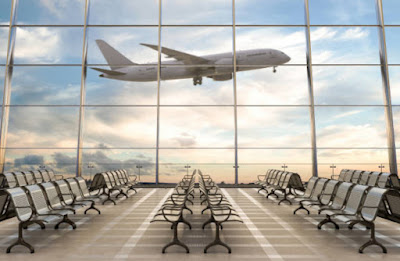Airports
Airports
Today, the Aviation Industry is tackling numerous pressures and challenges due to COVID-19. Per a recent report published by the IATA (International Air Transport Association), the COVID-19 crisis will see airline passenger revenues drop by $314 billion in 2020, a 55% decline compared to 2019.
While the industry is dealing with multiple pressures due to reduced revenues, airports and airlines are also faced with the task of building back passengers’ confidence in air travel and ensuring their safety to resume air travel. There are guidelines and SOPs laid down by governments and authorities like the IATA and MOCA for resuming domestic and international travel such as ensuring minimum social distance, enabling contactless methods for check-in and boarding, e-payments etc.
The challenge for airports now is to implement these adapted operational concepts while reducing costs to combat this crisis.
Most airports today are therefore making investments in technology solutions to enable a contactless and safe journey for passengers, which is now also considered as ‘The new normal’ in air travel. As this industry is putting in efforts to digitize the Passenger journey, there is also a need to explore the use of technology in the area of back-office operations. Leveraging digital technologies in the area of back office can present multifold opportunities for reducing costs and delivering step change benefits in revenue generation and operational performance of airports.
Airports as a Business Enterprise:
In recent years, airports started diversifying revenue sources by using innovative strategies like increasing rental rates, bidding for concessionaires and generating opportunities in other commercial avenues such as parking and retail. This has resulted in a considerable increase in non-aeronautical revenues such that non-aero revenues are now accounting for a high percentage of total revenue. Today, an average of 39.4% of global airports’ revenues are derived from non-aeronautical sources. (Source: 2019 ACI Airport Economics Report).
However, with growing non-aeronautical revenue sources, airports have now become businesses, where they need to look at revenue and cost management strategies to optimize yields and profitability. The challenge faced by most Airport Managers today is that there is limited automation in this area and insufficient insights into the sales data, which can help them develop the right pricing strategies to provide the required growth while coping with the uncertainties in this industry.
Over the years, airlines have built sophisticated algorithms as well as pricing strategies & systems around revenue management; however, demand-led pricing strategies have not been exploited by most Airport Revenue Managers till date.
Pricing Strategies for Effective Revenue Management
Within airports, managing revenue is a little more complicated as airports need to look at multiple aspects to maintain value across all parties.
Let us first understand revenue structures for an airport. The below diagram depicts the classification of aero (air operations related) and non-aero (commercial revenues not directly related to aircraft operations).
While aeronautical revenues are related to airline, passenger, and freight processes, non-aeronautical revenues comprise commercial revenues from sources such as land lease, Duty Free, Retail, Parking fees, and other commercial activities as depicted below.
Retail shops, food & beverage outlets and car parks are perceived as integral parts of an airport.These so-called “non-aero revenues” have long been a reliable and profitable source of income for airports. However, in recent years, airports’ vital income source has been under attack. Now, due to the COVID-19 crisis, airport terminals around the world are deserted. Is COVID-19 the last bullet that will break airports’ fortress? We propose not, if airports embrace current challenges and pivot their mind-set to a data-driven, collaborative approach while differentiating their commercial offerings.
Non-aero revenues are under attack
Non-aero revenues are airports’ backbone. With ongoing pressure from airlines on aeronautical fees, non-aero revenues are more and more in focus. On a global scale, costs to serve passengers exceed fees airports receive from airlines. Even though non-aero only makes up 40 percent of airports’ revenues, it accounts for 80 percent of their profits
Top 3 Airports :
The airport has a mosque, two hotels, 12 lounges, large duty-free shopping areas and a health club with two squash courts, a gym, a spa and a swimming pool. An extensive public art program displays the works of acclaimed local and international artists. The airport also houses the famous ‘Lamp Bear' by Swiss artist Urs Fischer. HOK states, “Our design of the main passenger terminal emphasises Qatari hospitality and its Gulf-side location. The terminal gives visitors a spectacular and lasting impression of the country while providing them with a five-star travel experience.” The airport, built on reclaimed land is situated amidst a spectacular man-made lagoon, well-manicured gardens and a natural bay. The airport is about a third of the size of Doha, with a 600,000 square metre and four-stories-high Passenger Terminal Complex, which equates to 75 soccer fields. Presently, the airport has the capacity to handle 8,700 passengers per hour, more than 30 million passengers a year, and is undergoing further expansion to accommodate more than 50 million passengers. HIA has two parallel runways, among the longest in the world, designed to cater to next-generation aircrafts including the Airbus A380.
HANEDA AIRPORT (Tokyo):
Haneda’s main attraction is its location very close to the center of Tokyo. New stations on the Tokyo Monorail and the Keikyu line have made travel times to the city center among the shortest of the world’s major international airports. It takes as little as 13 minutes to get from the airport to Shinagawa station on the Keikyu line, where passengers can transfer to the Shinkansen bullet train, or to Hamamatsucho station by monorail. From Hamamatsucho, it is just six minutes to Tokyo Station. This compares favorably to the travel times for major international airports such as JFK in New York (35 minutes) and Charles de Gaulle in Paris (29 minutes). Arriving at the airport could hardly be easier: the monorail station is just a one-minute walk from the departure lobby.
Haneda’s unbeatable location and early-morning and late-night flights have already made the new international facility a big hit with local travel agencies. The new terminal makes it much easier for people in Japan and nearby countries in Asia to take weekend breaks abroad, leaving on a flight after work on Friday and returning early in time to head straight to the office on Monday morning. The airport’s central location and convenient connections to domestic flights look certain to change the way tourists and business passengers travel.
Haneda’s new five-story International Passenger Terminal is an attraction in itself. The arrival lobby takes up the second floor, with a soaring departure lobby on the third floor. A large entertainment space that includes 105 shops and restaurants is another major feature of the terminal building. The “Edo Market Place,” after the old name for Tokyo, comprises the Edo Koji zone on the fourth floor and Tokyo Pop Town zone on the fifth. The facility offers some great “Made in Japan” shopping and dining options—even if you don’t have a plane to catch!
The Edo Koji zone is modeled after a typical street from the Edo Period (1603–1868), lined with restaurants selling traditional Japanese dishes like sushi, sukiyaki, ramen and soba noodles, and tonkatsu (fried pork cutlet). Restaurants serving Japanese fine cuisine are also available, such as Hyakuzen, which offers a changing menu of seasonal specialties. The Dining 24 Haneda Diner is open 24 hours a day. Walking around this impressive area under its dynamic soaring roof gives visitors a taste of the traditions and culture of old Japan. Many gift shops can also be found on this floor, offering items popular with foreign passengers: T-shirts with Japanese writing on them, traditional wrapping cloths (furoshiki), traditional paper goods, and a wide array of bags.
The fifth-floor Tokyo Pop Town presents a completely different side of Japan. Modeled after contemporary Tokyo, the facilities give visitors an introduction to the cultural scene in Japan today. The "Cool Zone" includes shops with an array of action figures and science-related toys. Perhaps the most striking feature is the Starry Café, the world’s very first airport planetarium-café. Over 40 million stars can be projected on the domed ceiling of the café. When it is not being used as a planetarium, the space becomes a café and bar, where customers can enjoy a drink under the stars. The "Hot Zone," meanwhile, has a 50 meter slot-car racing circuit as well as shops specializing in the anime figurines and other pop culture items popular with kids and grownups from around the world. The idea of the Tokyo Pop Town is to shine a spotlight on Japanese products and locations and to give visitors from around Asia and the rest of the world a taste of what is going on in Tokyo and the rest of Japan. (January 2011).
Changi Airport ( Singapore):
The focal point of Singapore’s status as a world-class aviation hub, Changi Airport is an unforgettable tourist destination in its own right. With a slew of accolades to its name, Singapore’s main airport boasts a trove of exciting activities, from shopping and dining to entertainment.
The airport comprises four terminals and Jewel Changi, a ten-storey lifestyle hub that seamlessly links to Terminals 1, 2 and 3, and fuses artistry, architecture and nature into a single structure.
Whether you’re in Singapore for a layover, or spending a week in our tropical paradise, Changi Airport is bound to enchant the moment you land. Here’s a small sample of what you’ll experience.
 |
| Terminal 3- Changi |
Nature nurtured

Much like Singapore—which is globally renowned as a ‘City in A Garden’—Changi Airport is home to green spaces and verdant gardens for travellers looking to unwind and stretch their legs after a long flight.
To witness the most spectacular of these spaces, take a stroll over to Jewel Changi, and marvel at the HSBC Rain Vortex, a 40-metre-high indoor waterfall flanked on all sides by tropical plants and over 2,000 trees.
Smaller spaces that are no less charming include the Butterfly Garden at Terminal 3, the Sunflower Garden at Terminal 2 and the Cactus Garden at Terminal 1—featuring over 100 species of cacti and arid plants.
Nature lovers visiting the latter will be able to deepen their knowledge of nature’s intricacies, as they witness butterflies emerging from their chrysalides at the Emergence Enclosure.
















Comments
Post a Comment